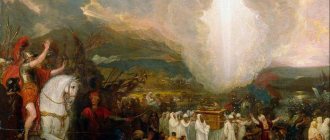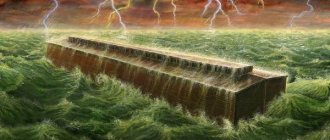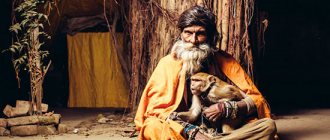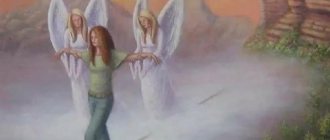Reasons for confusion
First of all, it is worth noting that it arises due to insufficient familiarity with the Bible, because this book is the source of reliable information about these people. But most people prefer to read biblical films, but they are often full of inaccuracies or fiction. Many directors distort the plot by creating stories that bring together characters whose life paths have never crossed in time. For example, in one of them, Noah, sailing on the ark, met Lot (who lived about 500 years after the flood), who was sailing on a catamaran! Therefore, it is not surprising that questions like “ How many animals did Moses take on his ark?” "and the like.
Naturally, there are many skeptics who question the fact of the Flood and the miracles of the Mosaic era, for example, the parting of the Red Sea and allowing an entire people to walk on the dry seabed. This is their opinion, to which they are entitled. Of course, there are many arguments and facts proving the opposite, but that’s not what we’re talking about now. The purpose of this article is to summarize the information that is in the original source, and leave the right to believe or not to the reader.
Riddles for attentiveness and logic
Answer: 2+3+3*11=38
1. What is: 6 legs, 2 heads, 1 tail? (Answer - Horseman)
2. There were 10 sparrows sitting on a branch, one of them was eaten by a cat. How many sparrows are left on the branch? (Answer - Not a single one, they all scattered)
3. What did the elephant do when he came to the field? (Answer: I was picking grass)
4. How far can you run into the forest? (Answer - Until the middle - then you run out)
5. What is two plus two times two? (Answer: first you need to multiply)
6. Half a snout, one eye, one ear? (Answer: The pig is peeking around the corner)
7. Back and forth, oh my God, how nice? (Answer - Swing)
8. God, how nice does it feel when you lie on me? (Answer - Hedgehog carries an apple)
9. What is: green, bald and galloping? (Answer - Soldier at a disco)
10. What is black on one leg? (Answer - One-legged African American) 11. Black on two legs? (Answer - Two one-legged African Americans) 12. Black on three legs? (Answer - Royal) 13. Black on four legs? (Answer - One-legged African American man on the piano)
14. How to catch 9 elephants? (Answer - Catch 10 elephants and release one)
15. How do you say “I don’t know” in English? - “I don’t know” - So no one knows. Who else should I ask? (Answer: “I don’t know”)
16. What came first: the egg or the chicken? (Answer - Philosophical question)
17. With onions, with eggs, but not a pie. What is this? (Answer: Robin Hood)
18. How can an old man transport a wolf, a goat and a cabbage across a river if only two can fit in the boat; considering that a wolf can eat a goat, and a goat can eat cabbage? (Answer - First take the goat, then the wolf, bring the goat back, transport the cabbage and then the goat again)
19. Problem: Cow - 2 Sheep - 2 Pig - 3 Dog - 3 Cat - 3 Duck - 3 Cuckoo - 4 Horse - 5 Rooster - 8 Donkey - ? (Answer - Cow - 2 - ME Sheep - 2 - BE Pig - 3 - ONK Dog - 3 - WOOK Cat - 3 - MEOW Duck - 3 - QUACK Cuckoo - 4 - KOO-KOO Horse - 5 - I-GO-GO Rooster — 8 — KU-KA-RE-KU Donkey — 2 — IA)
20. You are driving like this in a car. Suddenly a granny, a woman and a child run out onto the road. Who will you push? (Answer - Brake pedal)
21. Which wheel does not spin when turning right? (Answer - Spare)
22. On different banks of the river there are an imp and his father the devil. The river is very deep, it is impossible to swim across. There is a policeman standing on the bridge and not letting anyone in. How can a little devil get to his father? (Answer - Go up to the policeman, start pestering him with stupid questions, he will eventually say “go to hell!” and he will go)
23. An electric train was running. Where did the smoke go from it - north, south, west or east? (Answer - It’s not electric)
24. The soldiers were walking and found a pickled cucumber. Who did they eat the cucumber with? (Answer: With Alena)
25. You are sitting on a plane, there is a horse in front of you, a car behind you, where are you? (Answer - On the carousel)
26. Mary’s father has five daughters: 1. Chacha 2. Cheche 3. Chichi 4 Chocho. What is the name of the fifth daughter? (Answer: Mary)
27. During heavy rain, a bus was driving along the highway. All the passengers on the bus were asleep and only one driver was awake. What was the name of the bus driver and what were the bus numbers? (Answer - The driver’s name is Tolka, and the numbers were wet)
28. Three calves. How many legs? (Answer - Four. No matter how many calfs there are, there will still be four legs)
29. Is it possible to light a match underwater? (Answer: Yes, in a submarine)
30. What can you hold only in your left hand? (Answer - Right hand)
31. What is Adam's front and Eve's back? (Answer - Letter “a”)
32. Which word starts with three “Gs” and ends with three “Is”? (Answer: Trigonometry)
33. What word ends with three “Es”? (Answer: Long-necked)
34. A hunter walked past the clock tower. He took out a gun and fired. Where did he end up? (Answer - To the police)
35. A cowboy approaches the saloon counter and asks the bartender to pour him a glass of water. Instead, the bartender pulls out a revolver and shoots. The cowboy drops a quarter on the counter and walks away. What's the matter? (Answer: The Cowboy hiccupped, but stopped because he was scared)
36. Riddle: In a completely empty room with a dry, creaky wooden floor, a hanged man is hanging in a loop of rope tied to a lonely hook screwed into the middle of the high ceiling. How did this happen? (Answer - I stood on a piece of ice, pushed it away and hanged myself, the ice melted, the water went into the cracks, the floor dried out)
What is known about Moses?
The first mention of him is in the book of Exodus, which tells about his birth and life until the age of 80. His father was Amram and his mother Jochebed, both descended from Levi, the great-grandson of Abraham. According to biblical chronology, Moses was born in 1593 BC. in Egypt at a time when its people - the Jews - were in slavery. Moreover, the life of the newborn Moses was immediately threatened: shortly before his birth, the order was given to kill all male babies. But his mother put him in a papyrus basket and laid him on the banks of the Nile, where the child was found by the Pharaoh's daughter, who adopted the boy. Therefore, he was given the name Moses, which means “taken out of the water.”
He was raised at the court of the pharaoh, received a higher education, and had a wonderful career open to him, but he knew about his origins and really wanted to help his enslaved people. When he was 40 years old, he left Egypt and settled in the Madiyam region. After another 40 years, he received instructions from God to return to Egypt and lead the Jewish people out of captivity and bring them to the land where their ancestors lived. This was preceded by 10 plagues of the Egyptians, and the climax was the crossing of the Red Sea , which became the grave for the pharaoh and his army.
What followed was a grueling 40 years of walking in the Sinai Desert .
But Moses failed to cross the Promised Land and died at the age of 120. If we briefly answer the question of what Moses did, who he was and what role he played in the history of the Jewish people, it should be mentioned that he was an outstanding leader, military leader, judge, prophet and author of six books of the Bible. But it was not directly related to the flood, so the question of how many animals Moses took on his ark does not make sense.
New in blogs
Words (all) later insertion
Only 7 pairs of pure and 7 pairs of unclean
—————
Jonathan Sarfati
Translation: Irina Malcheva, edited by Alexey Kalko
Many skeptics argue that the Bible cannot be trusted because the Ark could not accommodate all the different species of animals. This has led many Christians to abandon belief in the Great Flood described in Genesis, or to believe that it was a localized flood that affected a relatively small number of animals. However, they usually don't even do any calculations. On the other hand, this issue was discussed in detail in the classic creationist book, The Genesis Flood,1 published back in 1961. A more detailed and advanced technical analysis of this and many other issues is presented in John Woodmorappe's book Noah's Ark: a Feasibility Study. This article is based on materials from these two books, as well as some of our own calculations. We asked ourselves two questions: How many types of animals did Noah need to take on the Ark? Was the Ark big enough to contain all the animals?
The Bible describes Noah's Ark as a huge, stable, seaworthy vessel - 300 cubits long, 50 cubits wide and 30 cubits high.
How many types of animals did Noah need to take on the Ark?
The following Bible verses answer this question:
Genesis 6:19–20
Bring also into the ark two of every living creature, and of every flesh, so that they may remain alive with you; let them be male and female. Of birds according to their kinds, and of cattle according to their kinds, and of every thing that creeps on the earth according to their kind, two of every kind will come to you, so that you may live.
Genesis 7:2,3
And of every clean cattle take seven by seven, male and female, and of every unclean cattle by two, male and female; also from the birds of the air in sevens, male and female, to preserve a tribe for the whole earth.
In these verses the word "cattle" is translated from the Hebrew behemah, and refers to all vertebrates in general. The word translated "creeping things" in the original Hebrew is remes, and it has several meanings in Scripture, but here most likely refers to reptiles.2 Noah did not need to take the sea creatures,3 because the Flood would not necessarily have brought to their extinction. However, the turbulent waters may have led to a mass extinction event, as evidenced in the fossil record, and many of the creatures that inhabited the ocean likely became extinct due to the Flood.
The average size of the animals on the Ark was about the size of a small rat, according to Woodmorappe's modern calculations, while only about 11% of the animals were much larger than a sheep.
Be that as it may, if the wise God decided not to preserve some of the inhabitants of the ocean, this did not concern Noah. Also, Noah did not need to take plants into the Ark - many of them could survive in seed form, others on floating mats of vegetation. Many insects and other invertebrates were small enough to also survive on these mats. The flood destroyed all land animals that breathed through their nostrils except those in Noah's Ark (Genesis 7:22). Insects do not breathe through their nostrils, but through tiny holes in their outer chitinous covering.
Clean Animals: Biblical commentators have disagreed as to whether the Hebrew spells out "seven" or "seven pairs" of each kind of clean animal. Woodmorappe chooses the second option to give Bible skeptics a head start as far as possible. But the vast majority of animals were not pure and were represented by only two representatives. The term "clean animals" did not exist before the Law of Moses. But, given that Moses was the compiler of the book of Genesis, following the principle of “Scripture interprets Scripture,” the definition from the Law of Moses can be applied to the Ark situation. In fact, Leviticus 11 and Deuteronomy 14 list very few “clean” animals.
What is "genus"? God created a certain number of genera of animals with great capacity for variation within certain limits.4 The descendants of each of these different created genera, with the exception of man, are today most often represented by more than one species (according to modern classification). In most cases, species descended from the same created genus can be grouped into groups, which modern taxonomists (biologists who classify living things) call a genus.
One common definition of a species is “a group of organisms that can interbreed and produce fertile offspring, and cannot mate with other species.” However, most so-called species have not been tested to see who they can interbreed with and who they cannot (obviously this includes all extinct species). In fact, not only hybrids between so-called species are known, but also many examples of trans-generic crossing, that is, the “created genus” can in some cases be at the family level (according to the modern classification). Note that the identification of the concept of "created kind" with a modern taxonomic genus is also consistent with Scripture, since when the Bible spoke of genera, the Israelites should have been able to easily distinguish between them without having to test for the possibility of hybridization.
For example, horses, zebras and donkeys appear to have descended from the same created genus equidae (some kind of horse-like creature), since they can interbreed, even though their descendants are no longer capable of reproduction (sterile). Dogs, wolves, coyotes, and jackals appear to have descended from the canine (dog-like) creation. All types of cattle (and they are all pure) are descendants of the aurochs (primitive bull, Aurochs), so there had to be a maximum of 7 (or 14) cattle on board. The aurochs themselves could be descendants of a created lineage that also included bison and buffalo. It is known that lions and tigers can produce hybrid offspring called tigons or ligers, so they most likely came from the same created lineage.
On the Ark, most likely, there was dried, compressed and concentrated food. Noah probably fed his cattle primarily grain, with additional hay to provide fiber. Woodmorappe calculated that the volume of feed should have been 15% of the total volume of the Ark. Drinking water could occupy 9.4% of the total volume.
Woodmorappe counted about 8,000 genera, including extinct ones, so about 16,000 animals must have been present on board the Ark. Regarding extinct species, paleontologists have a tendency to assign a new genus name to each new discovery, but this is not justified. Therefore, the number of extinct genera is probably too exaggerated. For example, consider the group of the largest dinosaurs - sauropods - giant herbivorous lizards, which include, for example, Brachiosaurus, Diplodocus, Apatosaurus, etc. Usually 87 genera of sauropods are indicated, but only 12 of them are “accurately established” and another 12 are considered “relatively established.”5
One of the most common questions is: “How could all those huge dinosaurs fit on the Ark?” First, of the 668 estimated genera of dinosaurs, only 106 weighed more than 10 tons (adults). Secondly, as mentioned above, the number of genera of dinosaurs is most likely greatly exaggerated. But Woodmorappe deliberately takes these numbers, giving skeptics a head start. Third, nowhere in the Bible does it say that animals had to be taken onto the Ark as adults. The largest animals may have been taken as juveniles. The average size of the animals on the Ark was about the size of a small rat, according to Woodmorappe's modern calculations, while only about 11% of the animals were much larger than a sheep.
Another question often raised by atheists and theistic evolutionists is “how did pathogens survive the Flood?” This is an important question - it assumes that microbes were as specialized and infectious as they are now, so all the animals on the Ark must have been infected with every infectious disease that exists on Earth. But the bacteria were likely more resilient and only recently lost the ability to survive in or out of different vectors. In fact, even today, many bacteria can survive in insect vectors, carcasses, frozen or dehydrated states, or live in hosts without causing disease. After all, the loss of resistance to infection is consistent with the general degradation of living beings since the Fall.6
Was the Ark big enough to contain all the animals?
The ark had dimensions of 300 * 50 * 30 cubits (Genesis 6:15), which is approximately 140 * 23 * 13.5 meters, that is, its volume was equal to 43,500 m3. To put this into perspective, this is equal to the volume of 522 standard American railroad boxcars, each of which can hold 240 sheep.
If the animals were kept in cages of approximately 50*50*30 cm (volume 75,000 cm3), then 16,000 individuals could occupy only 1200 m3 or 14.4 wagons. Even if there were a million species of insects on board, this would not be a problem because they do not take up much space. If each pair was kept in a cage with a side of 10 cm or 1000 cm3, all types of insects would occupy a volume equal to 1000 m3, or 12 more carriages. This meant there was room for five trains of 99 cars each for food, Noah's family and an additional "territory" for the animals. In addition, insects are not included in the categories of behemah or remes mentioned in Genesis 6:19–20, so it is likely that Noah did not take them with him on the Ark.
The calculation of the total volume is quite fair, because it shows that the size of the Ark was sufficient to accommodate all the animals, and there was still more than enough space left for storing food, free space, etc. Perhaps to more efficiently fill the space of the Ark, cages were stacked on top of each other, and food was stored on top or next to them (to minimize the amount of food that people would have to carry), while still leaving plenty of gaps for ventilation. We're talking about an emergency situation, not luxury accommodation. And although there was already plenty of space on the Ark for animals to move, skeptics exaggerate the animals' need to move.
Even if we assume that it was impossible to stack one cage on top of another to save space on the floor, there would still be no problems. Based on recommended animal housing standards, Woodmorappe shows that all of them combined would have required less than half the floor area of the Ark's three decks. This arrangement of cages would allow the maximum amount of food and water to be placed on top of the cages - next to the animals.
Food requirements.
The Ark most likely contained dried, compressed and concentrated food. Noah probably fed his cattle primarily grain, with additional hay to provide fiber. Woodmorappe calculated that the volume of feed should have been 15% of the total volume of the Ark. Drinking water could occupy 9.4% of the total volume. This volume could be even smaller if they collected rainwater, which flowed through pipes into drinking troughs.
The Ark may have had slanted floors or cages with holes in the floor where manure would fall in and be washed away (there was plenty of water!) or it would be destroyed by vermicomposting (composting with worms), with earthworms serving as an additional source of food.
Requirements for waste collection
It's unlikely that people had to clean their cages every morning. The Ark may have had slanted floors or cages with holes in the floor where manure would fall in and be washed away (there was plenty of water!) or it would be destroyed by vermicomposting (composting with worms), with earthworms serving as an additional source of food. Very thick bedding can sometimes last for a year without replacement. Absorbent materials (such as sawdust, soft wood shavings and especially peat) could reduce moisture and therefore odors.
Hibernation
So, the Ark was quite adequate for the space, food, and waste requirements, even if the animals had normal sleep-wake cycles. But hibernation could further reduce these needs. Yes, the Bible does not mention hibernation anywhere, but it does not exclude it either. Some creationists believe that God created the hibernation instinct specifically for the animals on the Ark, but we cannot say this categorically.
Some skeptics claim that taking food on board eliminates the possibility of hibernation, but this is not true. Hibernating animals, despite the popular stereotype, do not sleep all winter, so they would still need food from time to time.
Conclusion
This article showed that the Bible can be trusted in practical matters such as Noah's Ark. Many Christians believe that the Bible is trustworthy only in matters of faith and morals, not science. But we need to remember that Christ Himself said to Nicodemus (John 3:12): “If I told you about earthly things and you do not believe, how will you believe if I tell you about heavenly things?”
If Scripture were wrong in areas that can be verified by human experience, such as geography, history, and the natural sciences, how could we trust it in matters such as the nature of God or life after death, which are not subject to practical verification? Therefore, Christians should follow these words of the Apostle Peter: “Sanctify the Lord God in your hearts; Be always ready to give an answer to everyone who asks you to give a reason for the hope that is in you with meekness and reverence” (1 Peter 3:15) when skeptics claim that the Bible contradicts known “scientific facts.”
Christians will be able to fulfill this command and effectively respond to skeptics' arguments against the Ark if they read John Woodmorappe's book, Noah's Ark: A Case for Feasibility. This remarkable book is the most comprehensive analysis ever published of the gathering of animals onto the Ark, their care and feeding, and the subsequent scattering. For example, some skeptics argue that after the Flood the soil would have been too salty for plants. Woodmorappe shows that salt can be easily washed away by rainwater.
Woodmorappe devoted seven years to this scientific and systematic refutation of virtually all arguments about the unreality of the Ark and the alleged difficulties of the biblical account, and other related issues. Nothing like this has ever been written before—this is a powerful defense of the story of the Ark in Genesis.
“Not only does it contain facts and details that children will find fascinating, but it will also be a great resource for Bible study projects and lessons about the Ark and the Flood. Anyone who is looking for answers to various questions about the Ark, especially those asked by skeptics, can be advised to read the book “Noah’s Ark.”
References and Notes 1.C. Whitcomb, and H. M. Morris, The Genesis Flood, Phillipsburg, NJ, USA, Presbyterian and Reformed Publishing Co., 1961. Return to text 2.J. Jones, 'How many animals on the Ark?' Creation Research Society Quarterly 10(2):16–18, 1973 Return to text 3. It is time for some atheist skeptics to show their open minds and really read the Bible. Then they would stop making jokes about whales splashing up the ladder and aquariums on the Ark. Return to text 4. One of the common misconceptions of evolutionists is that variation within a genus supposedly proves evolution “from molecules to man.” The examples they give, such as the birch moth or bacteria becoming resistant to antibiotics, are indeed examples of natural selection. But this is not evolution. Evolution requires the creation of new information, whereas natural selection sorts and can remove information through the loss of genetic diversity. Natural selection can explain variation, but it cannot explain the origin of moths or bacteria. In the case of moths, natural selection simply changed the relative abundance of black- and light-spotted butterflies. Both forms already existed in the population, so nothing new was created. [After the publication of this article, it turned out that the butterfly photographs were staged, which further undermines this “evidence” - see Goodbye, peppered moths: A classic evolutionary story comes unstuck] The same applies to dog breeds. By choosing very large or, conversely, very small individuals, the Great Dane and Chihuahua breeds were developed. But these breeds have lost the size-specific information contained in their genes. See Dogs breeding dogs? Creation 18(2):20–23. [Cm. Also What is Evolution?] Return to text 5.S. McIntosh, Sauropoda, in Wieshampel, D. B. et al., The Dinosauria, University of California Press, Berkeley, California, p. 345, 1992. Return to text 6. Wieland, 'Diseases on the Ark', Journal of Creation (formerly title Creation Ex Nihilo Technical Journal) 8(1):16–18, 1994 Viruses often become more infectious due to random mutations that lead to changes in their protein coats. As a result, it becomes more difficult for antibodies to identify them, but the amount of information does not increase, that is, no real evolution occurs. Back to text 7.Reason and Revelation









